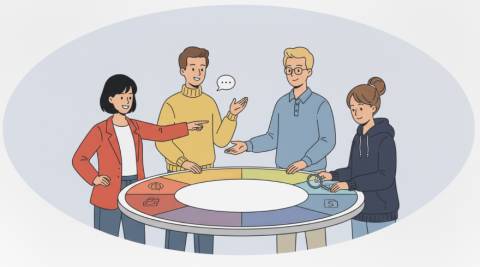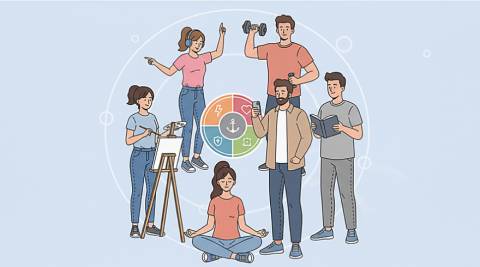The Complete Guide to DISC Personality Assessment

What DISC Measures and Why It Matters
DISC is a behavioral framework that explains how people prefer to communicate, decide, and collaborate under everyday conditions and pressure. Rooted in the work of psychologist William Moulton Marston, the model organizes observable behavior into four primary styles: Dominance, Influence, Steadiness, and Conscientiousness. Rather than labeling someone as good or bad, it highlights the patterns behind how we approach tasks, interact with others, and react to change. By focusing on how, not who, DISC creates a neutral language that teams can use to reduce friction and enhance cooperation.
In workplaces of every size, a shared model for behavior can transform meetings, feedback, and project handoffs into smoother experiences. When quick clarity matters, the DISC personality assessment gives managers and contributors a reliable map for DISCussing preferences without making it personal. Because the model is descriptive instead of judgmental, people can acknowledge strengths, address blind spots, and experiment with new strategies in a psychologically safe way. The result is not a rigid label, but a practical lens for everyday problem-solving.
- Creates a neutral vocabulary for DISCussing interpersonal dynamics.
- Encourages self-awareness without stigma or clinical diagnosis.
- Improves collaboration by aligning communication to audience needs.
- Supports change initiatives through repeatable, lightweight practices.
When used thoughtfully, DISC accelerates trust, reduces misunderstandings, and helps teams design workflows that fit real people, not idealized job descriptions. The payoff appears in fewer rework loops, faster decisions, and smoother handoffs.
How the Four Styles Work Together
Each DISC style reflects a blend of pace and priority. Dominance tends to be fast-paced and results-focused, Influence fast-paced and people-focused, Steadiness more moderate and relationship-focused, and Conscientiousness more moderate and accuracy-focused. No one style is better than another; each brings distinct strengths and risks, and most individuals show a combination with one or two leading preferences. Context also matters, because stress, ambiguity, and audience can nudge behavior in predictable ways.
For personal insight that you can apply right away, a DISC personality profile assessment translates these tendencies into everyday tactics like adapting your meeting style, feedback timing, and decision process. In high-stakes projects, this shared map turns potential friction into complementary roles, because teams can intentionally balance pace with precision and relationships with results. When leaders model flexibility, people feel invited to flex as well, and the culture becomes more resilient under pressure.
- Dominance: decisive, direct, and comfortable with risk when the goal is clear.
- Influence: enthusiastic, persuasive, and skilled at sparking engagement.
- Steadiness: patient, supportive, and reliable in sustaining momentum.
- Conscientiousness: analytical, careful, and committed to quality standards.
| Style | Typical Pace | Primary Focus | Strengths | Overuse Risk | Best Support |
|---|---|---|---|---|---|
| Dominance | Fast | Results | Decisiveness, accountability | Impatience, bluntness | Clear goals, autonomy |
| Influence | Fast | People | Inspiration, storytelling | Overpromising, distraction | Audience, recognition |
| Steadiness | Moderate | Harmony | Stability, listening | Conflict avoidance, inertia | Time to iterate, inclusion |
| Conscientiousness | Moderate | Quality | Accuracy, risk management | Overanalysis, rigidity | Data access, standards |
Because styles are observable, you can test hypotheses in real conversations by adjusting tone, structure, and pace. Small experiments, repeated over time, compound into smoother collaboration and less rework.
Practical Benefits for Teams, Leaders, and Careers
Organizations adopt DISC because it makes the invisible more DISCussable. When a team knows how members prefer to brainstorm, decide, and follow through, meetings become shorter and outcomes become clearer. Leaders benefit by tailoring coaching to what each person values, whether that is autonomy, recognition, stability, or precision. Individual contributors use the framework to prepare for tough conversations, to negotiate roles on cross-functional work, and to design personal routines that harness their natural energy.
For scalable impact across departments, an accessible DISC personality assessment tool helps HR and L&D standardize language, training, and follow-up. Sales groups can map buyer cues to adapt discovery questions and proposal formats, while product teams can balance speed with quality by pairing complementary styles on critical tasks. Because the model is memorable, it sticks after workshops, and people reach for it under pressure when they need it most.
- Streamlined hiring and onboarding through consistent behavioral interviews.
- Faster conflict resolution by reframing tension as mismatched priorities.
- More effective 1:1s that align coaching style to motivation drivers.
- Healthier change management that anticipates reactions to ambiguity.
Across industries, the framework pays dividends by reducing friction in handoffs, clarifying expectations, and helping teams use difference as an asset rather than a fault line.
Choosing a Quality Instrument and Using It Ethically
Not all DISC offerings are equal, and thoughtful selection protects both users and outcomes. Look for instruments backed by clear methodology, reliability data, and transparent development practices. Ensure the vendor provides training for facilitators and guidance for debriefs, because interpretation quality determines whether insight turns into action. Privacy and informed consent matter as well, especially when assessments are connected to hiring or promotion decisions.
When screening options, it helps to verify report clarity, respondent experience, and how well the instrument supports action planning beyond the initial event. In evaluation conversations, a well-designed DISC personality assessment test should emphasize observable behavior, avoid clinical claims, and provide contextual advice for growth. Cultural and language adaptations should be documented, with inclusive examples that resonate across geographies and roles in the organization.
- Validate reliability and norm groups before enterprise rollout.
- Separate development feedback from high-stakes selection decisions.
- Offer voluntary participation and protect individual data.
- Pair results with coaching, not just a static report.
Ethical use builds credibility, encourages participation, and ensures that insights are used to enable people rather than to box them in.
Reading Results Wisely: Patterns, Context, and Pitfalls
Great results start with great questions. Instead of asking “What style is right,” shift to “What does this situation demand, and how can I flex to meet it.” Effective interpretation looks at blends, intensity, and environment, because most people adjust in predictable ways when the stakes rise. Consider both your natural comfort zone and your adapted behavior under pressure, then plan simple experiments to expand your range without sacrificing authenticity.
Be cautious with shortcuts, because simple labels can obscure nuance and encourage bias. Although it can be tempting to click a viral link for a free DISC personality assessment, quality and depth vary widely across providers. Focus on patterns that show up across contexts, and watch for overuse risks that can flip strengths into liabilities under stress. Partner with a trained facilitator to connect insights to your goals, and keep notes on what works so you can refine your playbook over time.
- Avoid stereotyping teammates based on a single letter or color.
- Use results to plan actions for meetings, feedback, and decision gates.
- Revisit insights after milestones, because new contexts reveal new patterns.
- Balance self-acceptance with stretch goals that fit your role and season.
A DISCiplined approach turns a snapshot into a living practice that compounds across projects, relationships, and career transitions.
Implementation Roadmap: From Insight to Everyday Habits
Rollouts that stick treat DISC as a shared language, not a one-time event. Before administering any instrument, align on purpose, success metrics, and communication guidelines. Managers should set the tone by modeling curiosity and flexibility, while HR ensures that data handling meets privacy standards. After people receive reports, schedule debriefs that focus on application, not just reading scores aloud.
To make change visible, leaders can anchor new habits in recurring rituals like project kickoffs and retros. In these regular touchpoints, teams can refer to themes discovered through DISC personality assessments, then commit to small adjustments in meeting flow, decision rights, and feedback cadence. Lightweight templates such as one-page team charters codify agreements so they survive busy seasons and new hires.
- Week 1: Introduce the model, set intent, and confirm logistics.
- Week 2: Complete the instrument and schedule facilitated debriefs.
- Week 3: Create personal action plans and team collaboration norms.
- Week 6: Review progress, tune practices, and celebrate momentum.
By weaving insights into operating rhythms, teams convert understanding into performance improvements that accumulate quarter after quarter.
Case Studies and Real-World Scenarios
Consider a product team struggling with launch delays. Postmortems revealed that decisions bounced between speed advocates and quality guardians, with no agreed playbook for trade-offs. After introducing DISC, the group mapped core responsibilities to strengths, clarified decision criteria, and designed pre-mortem checkpoints. Cycle time dropped, rework declined, and the team reported higher satisfaction scores in pulse surveys. The key wasn’t changing who people were; it was aligning contributions and expectations with clarity.
In another scenario, a client services unit faced rising escalations tied to misread customer cues. As the team practiced adapting questions, tone, and pacing, their active listening improved, and call-backs reduced significantly. During coaching, a targeted use of a personality DISC assessment helped new hires translate feedback into real conversations faster. Managers then reinforced these wins by spotlighting examples in stand-ups and by refining playbooks with scripts that matched common buyer profiles.
- Sales: Map buyer signals to meeting structure, then iterate discovery prompts.
- Operations: Pair complementary styles on urgent tasks to balance speed and accuracy.
- Customer success: Coach de-escalation tactics that respect the client’s pace.
- Leadership: Use style diversity in strategic off-sites to widen solution space.
Across these stories, the most durable gains came from small, teachable routines that teams repeated until they became cultural reflexes.
FAQ: Common Questions About DISC
Is DISC a personality test or a behavior framework?
DISC describes observable behavior and preferences, not clinical traits, so it’s best viewed as a practical framework for communication and collaboration. The focus is on how people act, decide, and interact in different contexts, which makes it easy to apply without medicalizing everyday teamwork.
Can my style change over time?
Your core preferences tend to be stable, but context can shift how strongly you express them. New roles, leaders, or constraints can nudge behavior, and intentional practice can broaden your range so you flex more easily under pressure.
How accurate are the results?
Quality depends on instrument design, clarity of items, and norm groups that reflect your population. Accuracy improves when results are debriefed by trained facilitators who connect patterns to real situations and help you craft experiments rather than sweeping conclusions.
Should DISC be used in hiring decisions?
Use caution in high-stakes selection, because misapplication can create bias and legal risk. It’s better to treat data as one lens for structured interviews, work samples, and reference checks, rather than a gatekeeper that overrules demonstrated competence.
What’s the best way to get started?
Begin with a clear purpose, choose a reputable provider, and plan a debrief that converts insight into actions for meetings, feedback, and decision-making. For quick orientation sessions, many teams start with workshops where the facilitator explains the model before introducing a DISC assessment personality test that supports practical next steps.
Latest News



